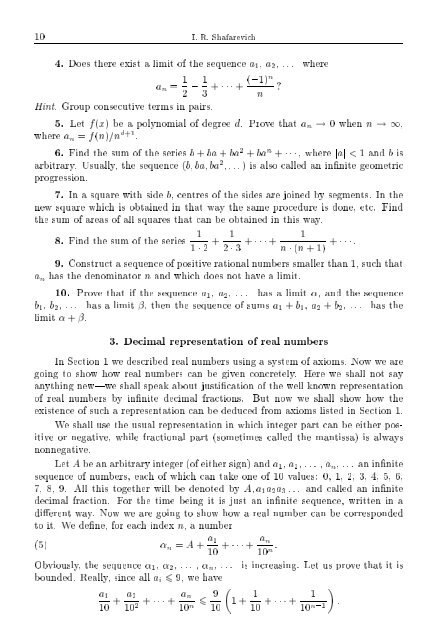SELECTED CHAPTERS FROM ALGEBRA I. R. Shafarevich Preface
SELECTED CHAPTERS FROM ALGEBRA I. R. Shafarevich Preface
SELECTED CHAPTERS FROM ALGEBRA I. R. Shafarevich Preface
You also want an ePaper? Increase the reach of your titles
YUMPU automatically turns print PDFs into web optimized ePapers that Google loves.
10 I. R. <strong>Shafarevich</strong>4. Does there exist a limit of the sequence a 1 , a 2 , ... wherea n = 1 2 ; 1 (;1)n+ + ?3 nHint. Group consecutive terms in pairs.5. Let f(x) be a polynomial of degree d. Prove thata n ! 0whenn !1,where a n = f(n)=n d+1 .6. Find the sum of the series b + ba + ba 2 + ba n + , where jaj < 1 and b isarbitrary. Usually, the sequence (b ba ba 2 . . . ) is also called an innite geometricprogression.7. In a square with side b, centres of the sides are joined by segments. In thenew square which is obtained in that way the same procedure is done, etc. Findthe sum of areas of all squares that can be obtained in this way.18. Find the sum of the series1 2 + 12 3 + + 1n (n +1) + .9. Construct a sequence of positive rational numbers smaller than 1, such thata n has the denominator n and which does not have a limit.10. Prove that if the sequence a 1 , a 2 , ... has a limit , and the sequenceb 1 , b 2 , ... has a limit , then the sequence of sums a 1 + b 1 , a 2 + b 2 , ... has thelimit + .3. Decimal representation of real numbersIn Section 1 we described real numbers using a system of axioms. Now wearegoing to show how real numbers can be given concretely. Here we shall not sayanything new|we shall speak about justication of the well known representationof real numbers by innite decimal fractions. But now we shall show how theexistence of such a representation can be deduced from axioms listed in Section 1.We shall use the usual representation in which integer part can be either positiveor negative, while fractional part (sometimes called the mantissa) is alwaysnonnegative.Let A be an arbitrary integer (of either sign) and a 1 , a 2 ,... ,a n ,... an innitesequence of numbers, each of which can take one of 10 values: 0, 1, 2, 3, 4, 5, 6,7, 8, 9. All this together will be denoted by A a 1 a 2 a 3 ... and called an innitedecimal fraction. For the time being it is just an innite sequence, written in adierent way. Now we are going to show how a real number can be correspondedto it. We dene, for each index n, anumber(5) n = A + a 110 + + a n10 n :Obviously, the sequence 1 , 2 , ... , n , ... is increasing. Let us prove thatitisbounded. Really, since all a i 6 9,wehavea 110 + a 210 + + a n2 10 6 9 n 1+ 110 10 + + 1 :10 n;1
















